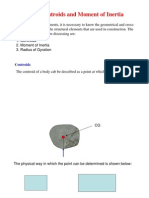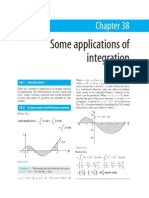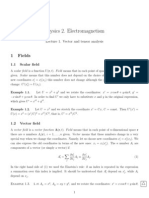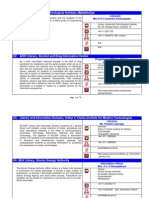Chapter 10 - Moments of Inertia of Areas: Neutral Axis Pure Bending
Chapter 10 - Moments of Inertia of Areas: Neutral Axis Pure Bending
Uploaded by
Sadeep MadhushanCopyright:
Available Formats
Chapter 10 - Moments of Inertia of Areas: Neutral Axis Pure Bending
Chapter 10 - Moments of Inertia of Areas: Neutral Axis Pure Bending
Uploaded by
Sadeep MadhushanOriginal Description:
Original Title
Copyright
Available Formats
Share this document
Did you find this document useful?
Is this content inappropriate?
Copyright:
Available Formats
Chapter 10 - Moments of Inertia of Areas: Neutral Axis Pure Bending
Chapter 10 - Moments of Inertia of Areas: Neutral Axis Pure Bending
Uploaded by
Sadeep MadhushanCopyright:
Available Formats
Chapter 10 - Moments of Inertia of Areas Consider the beam shown below
dA
Neutral Axis Pure Bending dF = k y dA
Internal forces are distributed forces whose magnitudes vary linearly with the distance y from an axis passing through the centroid of the section. Total resultant:
R = kydA = k ydA
1st moment, Qx The moment:
dM = ydF = ky 2 dA M = ky 2 dA = k y 2 dA
2nd moment, Qxx Moment of inertia Moment of inertia of an area by integration y y
dy x
y dx dA = ydx x
dA = (a - x)dy Rectangular moments of inertia
I x = y 2 dA I y = x 2 dA
Polar moment of inertia
J o = r 2 dA
J o = r 2 dA = ( x 2 + y 2 ) dA = y 2 dA + x 2 dA
Jo = Ix + I y
Radius of gyration of an area
y A x
Has moment of inertia
Concentrate this area in a thin strip
y A kx x
If a strip is to have same moment of inertia, the strip should be placed as shown. By def: I x = k x A
2
Thus:
kx = Ix A
2
Iy = ky A
ky =
Iy A
J o = ko A
ko =
Jo A
or
ko = k x + k y
Radius of gyration - the distance, from an axis that passes through the CG, at which all the area or mass of an object could be concentrated without changing its moment of inertia.
Parallel- Axis Theorem Consider:
dA B y A y' C d B' centroidal axis A'
Moment of inertia with respect to AA' I = y 2 dA
y = y + d
I = ( y + d ) 2 dA I = y 2 dA + 2d y dA + d 2 dA
MOI, I wrt centroidal axis 1ST moment wrt BB' = 0 centroid, C, is located on BB' total area
I = I + Ad 2
Parallel axis theorem
The moment of inertia of an area wrt to any given axis AA' is equal to the MOI I of the area with respect to the centroidal axis plus Ad 2 . Product of area, A, and the square of the distance d between the 2 axes.
J o = J c + Ad 2
The parallel axis theorem can be applied only if one of the two parallel axes passes through the centroid of the area.
Example 1). Given: y
x x2 y = 4 h a a2
h x a Find: Moment of inertia of shaded area with respect to the y-axis. y a x y dx dA = y dx
a x x2 I y = x 2 dA = x 2 4h a a2 0 1 I y = ha 3 5 3 a x x4 dx = 4 h 2 0 a a
h x
x4 x5 dx = 4 h 4 a 5a 2
a a3 a3 = 4 h 4 5 0
You might also like
- P1 Management Accounting Performance EvaluationDocument31 pagesP1 Management Accounting Performance EvaluationSadeep MadhushanNo ratings yet
- Chapter 10 - Moments of Inertia of Areas: Yda K Kyda RDocument4 pagesChapter 10 - Moments of Inertia of Areas: Yda K Kyda RJavier MejiaNo ratings yet
- 10-2 Parallel Axis Theorem For An AreaDocument4 pages10-2 Parallel Axis Theorem For An Areaewineta assefaNo ratings yet
- Properties of Surfaces (Centre of Gravity & Moment of Inertia)Document48 pagesProperties of Surfaces (Centre of Gravity & Moment of Inertia)Tauseef100% (1)
- Steel and Timber Design: Arch 415Document35 pagesSteel and Timber Design: Arch 415Glennson BalacanaoNo ratings yet
- L19 21Document41 pagesL19 21akhilesh120No ratings yet
- 9.11-9.15 Mass Moments of Inertia: R DM R DV R DVDocument7 pages9.11-9.15 Mass Moments of Inertia: R DM R DV R DVdearsaswatNo ratings yet
- Unit 5Document19 pagesUnit 5supraskyline2003No ratings yet
- II IIT IRP Physics Worksheet - 14 Q + Soln - SHMDocument17 pagesII IIT IRP Physics Worksheet - 14 Q + Soln - SHMAshwin KumarNo ratings yet
- INTEGRAL CALCULUS HandoutsDocument7 pagesINTEGRAL CALCULUS Handoutsurfriend_jjn05No ratings yet
- Moment of InertiaDocument47 pagesMoment of InertiaRahul NayakNo ratings yet
- Centroids PDFDocument13 pagesCentroids PDFNerinel CoronadoNo ratings yet
- Static Equilibrium: M M M F F FDocument41 pagesStatic Equilibrium: M M M F F FINMENo ratings yet
- 07 Cross-Sectional PropertiesDocument15 pages07 Cross-Sectional PropertiesHijir Della WirastiNo ratings yet
- Given A Potential Energy Graph, Oscillations Will Occur Between Turning Points Determined byDocument9 pagesGiven A Potential Energy Graph, Oscillations Will Occur Between Turning Points Determined byjdlawlisNo ratings yet
- Jackson9 2Document2 pagesJackson9 2EunHa SeoHwaNo ratings yet
- Moment of Inertia: I.E. P X (X) PXDocument6 pagesMoment of Inertia: I.E. P X (X) PXafzal taiNo ratings yet
- CN Chap10 - Moments of InertiaDocument25 pagesCN Chap10 - Moments of Inertiaengineer_atulNo ratings yet
- Moment of Inertia1 PDFDocument26 pagesMoment of Inertia1 PDFAashish BhandariNo ratings yet
- Moment of Inertia1 PDFDocument26 pagesMoment of Inertia1 PDFAashish BhandariNo ratings yet
- Moment of Inertia1 PDFDocument26 pagesMoment of Inertia1 PDFAashish BhandariNo ratings yet
- Chapter 9: Distributed Forces: Moments of Inertia: Da y R A y A P FDocument5 pagesChapter 9: Distributed Forces: Moments of Inertia: Da y R A y A P FEngr Aizaz AhmadNo ratings yet
- 1 General Solution To Wave Equation: One Dimensional WavesDocument35 pages1 General Solution To Wave Equation: One Dimensional WaveswenceslaoflorezNo ratings yet
- CE211_mid sem_solutionDocument6 pagesCE211_mid sem_solutionhimanshu.22523No ratings yet
- Brachistochrone Problem and It's Real-Life Application On ArchitectureDocument19 pagesBrachistochrone Problem and It's Real-Life Application On ArchitectureKhola KhanNo ratings yet
- APPLICATION 6 Moment of InertiaDocument44 pagesAPPLICATION 6 Moment of InertiaAnais RosalNo ratings yet
- Damped Vibration: Viscous and Coulomb DampingDocument14 pagesDamped Vibration: Viscous and Coulomb DampingEmmanuel KutaniNo ratings yet
- Moment of Inertia FormulaeDocument5 pagesMoment of Inertia FormulaeNilesh GopeeNo ratings yet
- Structural Dynamics Assignment No. 2Document10 pagesStructural Dynamics Assignment No. 2Prayush RajbhandariNo ratings yet
- CO-1 TutorialDocument4 pagesCO-1 TutorialK SureshNo ratings yet
- Center of mass mcdDocument11 pagesCenter of mass mcdyvan.duvan2000No ratings yet
- Parallel & Perpendicular Axis Theorem Engineering Mechanics.Document11 pagesParallel & Perpendicular Axis Theorem Engineering Mechanics.tomdas2011No ratings yet
- Moments of Inertia PDFDocument14 pagesMoments of Inertia PDFScott AlephNo ratings yet
- X X F DX X F: Applications of Integration Plane Areas by IntegrationDocument17 pagesX X F DX X F: Applications of Integration Plane Areas by IntegrationLee Anthony ChingNo ratings yet
- Motion 1 DDocument11 pagesMotion 1 Damit meelNo ratings yet
- Motion Along A Straight Line.: AP Physics C Review Equations For MechanicsDocument4 pagesMotion Along A Straight Line.: AP Physics C Review Equations For MechanicsCyou97No ratings yet
- Lesson 11 Moment of InertiaDocument12 pagesLesson 11 Moment of InertiaCamille SalmasanNo ratings yet
- Ch40 Young FreedmanxDocument26 pagesCh40 Young FreedmanxAndrew MerrillNo ratings yet
- Advection Diffusion Instantaneous ReleaseDocument9 pagesAdvection Diffusion Instantaneous ReleaseRoshanNo ratings yet
- Moi Lec 2 & 3Document14 pagesMoi Lec 2 & 3afzal taiNo ratings yet
- Pertemuan 2Document17 pagesPertemuan 2Syarifah Humaira Al'mudhirNo ratings yet
- MP13 Quantum Mechanics 2Document40 pagesMP13 Quantum Mechanics 2Ahmad Fikry IskandarNo ratings yet
- Airy ExampleDocument3 pagesAiry Examplevennila-puviNo ratings yet
- Nota Bending MoementDocument47 pagesNota Bending MoementAfiq NajmiNo ratings yet
- Physics 2. Electromagnetism: 1 FieldsDocument9 pagesPhysics 2. Electromagnetism: 1 FieldsOsama HassanNo ratings yet
- Vector analysis TD (1)Document3 pagesVector analysis TD (1)dekaliyacine78No ratings yet
- PDF 6 Mechanics of DBDocument18 pagesPDF 6 Mechanics of DBRizette PaloganNo ratings yet
- Moment Inertia IntegrationDocument34 pagesMoment Inertia IntegrationTsuki Zombina100% (1)
- Em Multi Pole RadiationDocument16 pagesEm Multi Pole Radiationspriya19854772No ratings yet
- CentroidDocument19 pagesCentroidragupathiindia100% (1)
- Calc 2 Lecture Notes Section 9.3 1 of 3: XXT y YtDocument3 pagesCalc 2 Lecture Notes Section 9.3 1 of 3: XXT y Ytmasyuki1979No ratings yet
- Question BaNK (New) Soft Branches IVCSDocument7 pagesQuestion BaNK (New) Soft Branches IVCSpukkokignoNo ratings yet
- Chapter 5 Applications of Definite Integral: 5-1 Area Between CurvesDocument21 pagesChapter 5 Applications of Definite Integral: 5-1 Area Between CurvesAfiqah ZainuddinNo ratings yet
- Green's Function Estimates for Lattice Schrödinger Operators and ApplicationsFrom EverandGreen's Function Estimates for Lattice Schrödinger Operators and ApplicationsNo ratings yet
- Student Solutions Manual to Accompany Economic Dynamics in Discrete Time, second editionFrom EverandStudent Solutions Manual to Accompany Economic Dynamics in Discrete Time, second editionRating: 4.5 out of 5 stars4.5/5 (2)
- Transformation of Axes (Geometry) Mathematics Question BankFrom EverandTransformation of Axes (Geometry) Mathematics Question BankRating: 3 out of 5 stars3/5 (1)
- Applications of Derivatives Errors and Approximation (Calculus) Mathematics Question BankFrom EverandApplications of Derivatives Errors and Approximation (Calculus) Mathematics Question BankNo ratings yet
- Application of Derivatives Tangents and Normals (Calculus) Mathematics E-Book For Public ExamsFrom EverandApplication of Derivatives Tangents and Normals (Calculus) Mathematics E-Book For Public ExamsRating: 5 out of 5 stars5/5 (1)
- The of Learning English LanguageDocument12 pagesThe of Learning English LanguageSadeep MadhushanNo ratings yet
- Template CVDocument2 pagesTemplate CVSadeep MadhushanNo ratings yet
- Human Rights and Civil EngineeringDocument5 pagesHuman Rights and Civil EngineeringSadeep MadhushanNo ratings yet
- Vector Calculus Applications in Electricity and MagnetismDocument6 pagesVector Calculus Applications in Electricity and MagnetismSadeep MadhushanNo ratings yet
- Distribution of Grade 6Document3 pagesDistribution of Grade 6Sadeep MadhushanNo ratings yet
- TLB TechnicalNotes ClayBrickworkDocument10 pagesTLB TechnicalNotes ClayBrickworkSadeep MadhushanNo ratings yet
- Faculty of Engineering: Answer ALL Questions in The Answer Sheet Provided. Time Allowed: 90 MinutesDocument5 pagesFaculty of Engineering: Answer ALL Questions in The Answer Sheet Provided. Time Allowed: 90 MinutesSadeep MadhushanNo ratings yet
- Human Rights and Civil EngineeringDocument5 pagesHuman Rights and Civil EngineeringSadeep MadhushanNo ratings yet
- Index Number: Faculty of EngineeringDocument1 pageIndex Number: Faculty of EngineeringSadeep MadhushanNo ratings yet
- CIMA-F2 Area B - Self Study Guide: Over View of The Syllabus Area CDocument3 pagesCIMA-F2 Area B - Self Study Guide: Over View of The Syllabus Area CSadeep MadhushanNo ratings yet
- F1andF2 Minorsyllabuschanges Frommay2013 Onwards FinalDocument1 pageF1andF2 Minorsyllabuschanges Frommay2013 Onwards FinalSadeep MadhushanNo ratings yet
- DirectoryofLibraries 26.06.2013Document72 pagesDirectoryofLibraries 26.06.2013Sadeep MadhushanNo ratings yet
- Field Selection 2012 Provesion ListDocument17 pagesField Selection 2012 Provesion ListSadeep MadhushanNo ratings yet








































































